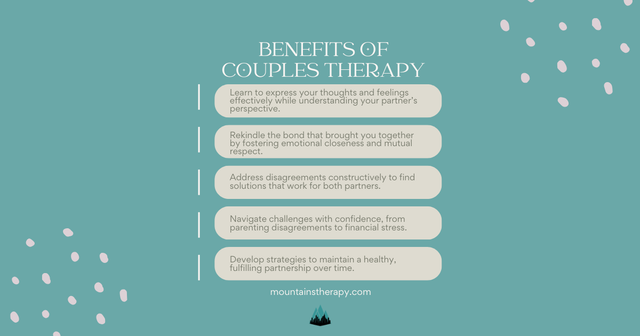The smart Trick of Aim Point Counseling That Nobody is Talking About
The smart Trick of Aim Point Counseling That Nobody is Talking About
Blog Article
Aim Point Counseling - The Facts
Table of ContentsAim Point Counseling Fundamentals ExplainedAim Point Counseling Fundamentals ExplainedEverything about Aim Point CounselingNot known Factual Statements About Aim Point Counseling Aim Point Counseling Things To Know Before You Get ThisAim Point Counseling Can Be Fun For Anyone
The longitudinal design involves a pre-treatment survey and two follow-up studies at 3- and 12-months post-intervention. The research study is established in 8 Relationships Australia Victoria centres, across city, outer suburban areas, and regional/rural websites. Relationships Australia, a non-government organisation, is the largest company of pair therapy and connection solutions in Australia.
These high rates of relationship failure have actually been consistently connected with unfavorable health and wellness consequences for both grownups and kids complying with divorce/separation.
The 8-Minute Rule for Aim Point Counseling
The results of separation and separation can be destructive, study indicates that high relationship dissonance in intact couples is also likely to have adverse outcomes.
Research to date has recognized both couple and individual elements that might add to connection dissonance. These consist of relationship fulfillment and commitment at the pair degree, and depression at the individual level.
Aim Point Counseling Things To Know Before You Buy
While most research studies indicate improvements in connection fulfillment following couple therapy, they are limited by the samples and procedures made use of, mostly temporary follow-up time frames, and evaluations that do not account for the dyadic nature of pair data., is an additional typically examined connection end result.
To summarise, study shows that couple-specific variables along with specific variables may anticipate the results of pair coaching and partnership solutions. The causal instructions of these partnerships, however, is much less clear. These monitorings are very important, since, to validate and guide the application of connection solutions such as couple counselling, empirical evidence should discover both the results of relationship services and the variables that forecast effective therapy.
For that reason, there is an expanding consensus that effectiveness researches must be matched by effectiveness research to best inform clinical technique [ 29] The restricted efficiency research that exists to date recommends that pair coaching can boost end results such as partnership fulfillment [33,43], communication abilities and basic well-being [44], at the very least in some European nations.

We currently recognize little regarding the accounts of pairs who seek out connection education and learning contrasted with those that look for connection therapy, or the outcomes of these programs. Unscientific evidence suggests that there might be substantial distress among at least some couples seeking partnership education and learning.
The Ultimate Guide To Aim Point Counseling
Responses includes individuals finishing questionnaires regarding their partnership (e.g. measures of interpersonal problems), and getting details on what their scores indicate. Cognitive-behavioural approaches promote altering cognitions to promote favorable relationships. These might consist of promoting practical attributions/expectations around negative partner behaviour [46] Lastly, in skills training, couples attend talks or presentations on relationship abilities, and practice these during facilitator-led activities [ 45]
These impacts have actually persisted for up to 4 years in some researches [47] These meta-analyses highlight constraints in the current literature on connection education and learning. Especially, the bulk of studies entailed couples from upper socio-economic histories who were not experiencing high connection dissonance [47,48] This example profile may not represent clients that typically provide for partnership education.
Getting The Aim Point Counseling To Work

Extremely little research study has analyzed the comparative advantages of pair coaching and connection education and learning programs. As clients are most likely to self-select right into these solution kinds, it is unclear whether particular relationship More Info distress profiles present to each solution kind, or certainly whether there is an interaction between providing profile, service kind and end result.
(https://a1mpoint.wordpress.com/2025/03/07/aim-point-counseling/)
Hence, we have included a 12-month follow-up to determine longer-term patterns and effects. The research uses a variety of standardized result procedures because some prior examinations have actually been criticised for their absence of standardised evaluation [50] Finally, using statistical evaluations that presume freedom of information, such as t-tests, or ANOVAs, has actually prevailed in previous researches [ 44,49]
As a result, we recommend to use multi-level statistical modelling procedures that manage for the inter-dependence of pair data to evaluate any kind of therapy effects. The details aims of the ECC research are to: 1. Map profiles of clients seeking area agency-based couple counselling vs. partnership improvement programs in terms of socio-demographic and partnership indications (such as relationship fulfillment, partnership commitment, social issues, and factors for participating in), along with health (such as clinical depression, general well-being) and health solution use (eg.
2. Identify whether pair counselling and partnership education and learning services enhance 3- and twelve-month results for relationship contentment, commitment, and depression, utilizing statistical analyses ideal to combine data. 3. Determine the loved one payments of customer elements (private and pair) and therapy/education variables to results at 3- and 12-months, and to sustainability of outcomes in time.
What Does Aim Point Counseling Mean?
Multi-level modelling to determine pre-post distinctions, managing for dyadic (pair) level. To contribute to the literature evaluating the performance of community-based couple therapy.
Report this page